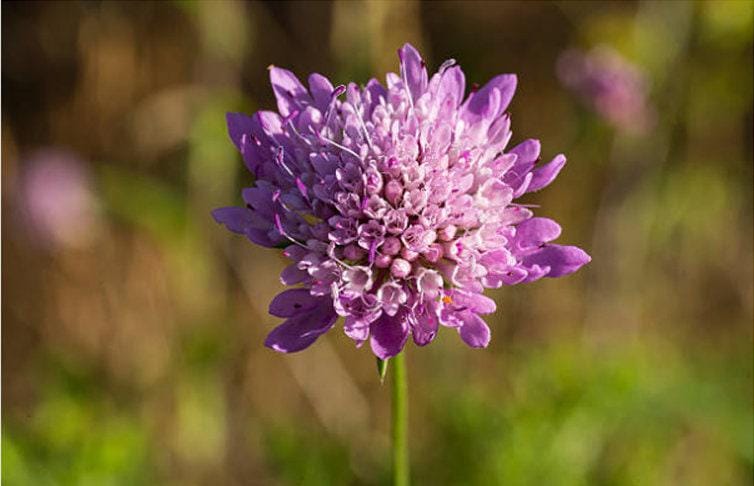Imperial Mix Pincushion Flowers (Scabiosa atropurpurea) are a stunning heirloom variety known for their intricately shaped, pincushion-like blooms in shades of deep burgundy, lavender, rose, white, and pink. These flowers are easy to grow, making them perfect for beginner and experienced gardeners alike. Thriving in full sun with well-drained soil, Pincushion Flowers add a graceful and airy touch to any garden.
Their long stems make them ideal for cutting gardens, and their blooms attract beneficial pollinators like bees and butterflies. Though grown as an annual in many climates, Pincushion Flowers will reseed in favorable conditions, ensuring they return year after year.
Common Names: Imperial Mix Pincushion Flowers, Mourning Bride
Latin Name: Scabiosa atropurpurea
Type: Flower
Life Cycle: Annual (can self-seed)
USDA Zones: 3 - 9
Stratification: Not Required
Germination Ease: Easy
Sunlight: Full Sun
Moisture: Moderate
Soil: Well-drained, sandy or loamy soils
Height: 24-36 inches
Spread: 12-18 inches
Color: Mix of deep burgundy, lavender, rose, white, and pink flowers
Bloom Season: Late Spring to Fall
Companion Plants: Carrots, Lettuce, Cucumbers (Pincushion Flowers attract pollinators and beneficial insects that can improve the productivity of these crops.)
Potential Toxicity: Non-toxic
Climate Adaptability: Thrives in temperate climates and tolerates both cool and warm weather
~ Sowing ~
When to Sow Outside:
Sow directly outdoors in early spring, 2-4 weeks before the last frost, or in late summer for fall blooms.
When to Start Inside:
Start indoors 6-8 weeks before the last frost date for earlier blooms. Transplant when soil is workable.
Days to Emerge:
10-14 days
Seed Depth:
Plant seeds 1/4 inch deep.
Seed Spacing:
Space seeds 6-12 inches apart.
Hardiness:
Somewhat frost-tolerant; can handle light frosts once established.
~ Growing ~
Soil:
Pincushion Flowers prefer well-drained, fertile soil but can tolerate poorer soils. Amend soil with organic matter for best results.
Watering:
Water consistently during early growth. Once established, Pincushion Flowers are moderately drought-tolerant but will bloom best with regular moisture.
Light and Temperature:
Thrives in full sun and tolerates a wide range of temperatures, from cool spring weather to warm summer heat.
Maintenance:
Deadhead spent blooms to encourage continued flowering throughout the season. Pincushion Flowers may self-seed, so remove seed heads if you want to prevent reseeding.
Container Friendly:
Can be grown in containers as long as they have adequate drainage. Choose deep containers to accommodate their root system.
~ Harvesting ~
When to Harvest:
Harvest blooms when they are fully open for fresh arrangements, or leave them on the plant to attract pollinators.
How to Harvest:
Cut stems at the base with sharp scissors or pruning shears.
Drying and Storing:
Flowers can be dried for ornamental purposes. Store dried flowers in a cool, dark place.
Edible Use:
Not typically edible, though flowers are often used in dried arrangements and decorations.
~ Seed Saving ~
Seed Collection:
Allow seed heads to dry on the plant. Once the heads are brown and dry, collect the seeds.
Seed Cleaning:
Remove seeds from the dried heads and clean off any excess plant debris.
Seed Storage:
Store seeds in a cool, dry place. Seeds remain viable for 1-2 years if properly stored.
~ Additional Information ~
Forage for Pollinators:
Pincushion Flowers are highly attractive to bees, butterflies, and other beneficial insects, making them a great addition to pollinator gardens.
Origin:
Native to southern Europe, Pincushion Flowers have been cultivated for centuries for their unique and delicate blooms.
Nomenclature:
The name “Scabiosa” comes from the Latin word for scabies, as the plant was once believed to treat skin ailments. The common name "Pincushion Flower" refers to the flower’s resemblance to a pincushion with protruding stamens.
History:
Pincushion Flowers have long been favored in both cottage gardens and formal flower beds for their unusual beauty and their utility as cut flowers.
Potential Toxicity:
Non-toxic to humans and animals.
Climate Adaptability:
Imperial Mix Pincushion Flowers are adaptable to a wide range of climates, tolerating both cool spring temperatures and warmer summer conditions.



















